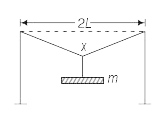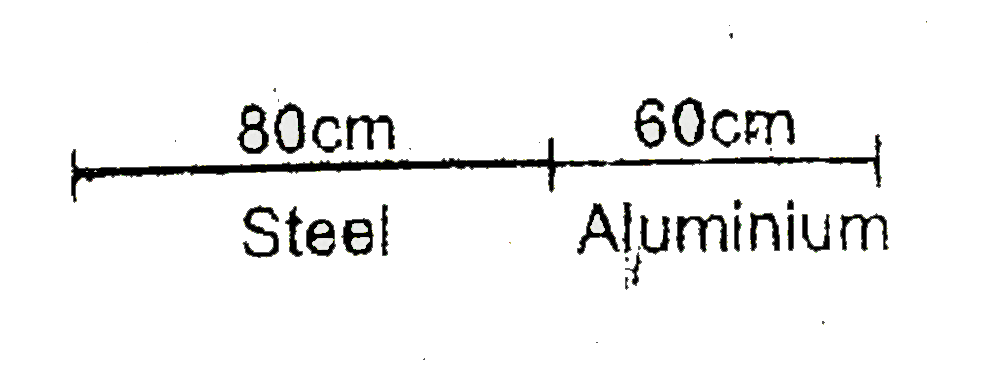An aluminium wire and a steel wire of same cross-sectional of were connected together. A 10 kg block loaded on the compound wire as shown in figure. Waves are set up in the compound wire. The minimum frequency of excitation for which standing waves are observed with point A as a node is density of aluminium and of steel=]
![An aluminium wire and a steel wire of same cross-sectional of 10^(-2)cm^(2) were connected together. A 10 kg block loaded on the compound wire as shown in figure. Waves are set up in the compound wire. The minimum frequency of excitation for which standing waves are observed with point A as a node is [L(1)=60cm,L(2)=86.6cm] density of aluminium =2.6g//cm^(3) and of steel=7.8g//cm^(3)]](https://d10lpgp6xz60nq.cloudfront.net/physics_images/VMC_PHY_XI_WOR_BOK_03_C12_E03_017_Q01.png)
223Hz
423Hz
327 Hz
427 Hz
The correct Answer is:C
Solving cycles/second.
Similar Questions
Figure shows an aluminium wire of length 60 cm joined to a steel wire of length 80 cm and stretched between two fixed supports. The tension produced is 40 N. The cross-sectional area of the steel wire is .1.0mm2 and that of the aluminium wire is 3.0 mm 2. What could be the minimum frequency of a tuning fork which can produce standing waves in the system with the joint as a node ? The density of aluminium is 2.6gcm−3and that of steel is 7.8gcm−3
 View Solution
View SolutionA steel wire of length 50√3cm is connected to an aluminium wire of length 60cm and stretched between two fixed supports. The tension produced is 104N, if the cross section area of each wire is 1mm2. If a transverse wave is set up in the wire, find the lowest frequency for which standing waves with node at the joint are produced . (density of aluminimum =2.6gm/cm3 and density of steel =7.8gm/cm3).
View Solution
Knowledge Check
- Question 1 - Select One
The self inductance of a solenoid that has a cross-sectional area of 1cm2, a length of 10 cm and 1000 turns of wire is
A0.86mHB1.06mHC1.26mHD1.46mH - Question 2 - Select One
A mild steel wire of length 2L and cross-sectional area A is stretched, well with in the elastic limit, horizontally between two pillars as shown in figure. A mass m is suspended from the mid-point of the wire strain in the wire is
 Ax22L2BxLCx2LDx22L
Ax22L2BxLCx2LDx22L
Figure shows an aluminium wire of length 60cm joined to a steel wire of length 80cm and stretched between two fixed supports. The tension produced is 40N. The cross-sectional area of the steel wire is 1.0mm2 and that of the aluminimum wire is 3.0mm2 The minimum frequency of a tuning fork which can produce standing waves in the system with the joint as a node is 10P (in Hz) the find P. Given density of aluminimum is 2.6g/cm3 and that of steel is 7.8g/cm3.
 View Solution
View SolutionAn aluminium wire of length 0.6 m and cross-sectional area 10−6m2 is connected to a steel wire of the same crosssectional area and length 0.866 m. The compound wire is loaded with 10 kg. Find the lowest frequency of excitation for which the joint in the wire is a node. Also find the number ofnodes, excluding the two at the ends of the wire. The density of aluminium is 2600kg/m3 andthatofsteel is 7800kg/m3
View SolutionAn aluminium wire of length 0.6 m and cross sectioal are and length 0.866 m .The compound wire is loaded with 10kg.Find the lowest frequency of exciation for which the joint In the the wire.The density of alumimium is 2600 kg m−3 and that of steel is 7800 kgm−3
View SolutionAn aluminium wire of cross-sectional area (10−6)m2 is joined to a steel wire of the same cross-sectional area. This compound wire is stretched on a sonometer pulled by a weight of 10kg. The total length of the compound wire between the bridges is 1.5m of which the aluminium wire is 0.6m and the rest is steel wire. Transverse vibrations are setup in the wire by using an external source of variable frequency. Find the lowest frequency of excitation for which the standing waves are formed such that the joint in the wire is a node. What is the total number of nodes at this frequency? The density of aluminium is 2.6×(103)kg/m3 and that of steel is 1.04×104kg/m2(g=10m/s2)
View SolutionA potentiometer wire has a resistivity of 109Ω cm and area of cross-section is 10−2cm2. If current of 0.01 mA passes through the wire, potential gradient is
View SolutionAn aluminium wire of cross-sectionbal area 1×10−6m2 is joined to a steel wire of same cross-sectional ara. This compound wire is stretched on a sonometer, pulled by a weight of 10kg. The total length of the compound wire between the bridges is 1.5m, of which the aluminium is 0.6m and the rest is steel wire. Transverse vibrationas are set up in the wire by using an ecternal force of variable frequency. Find the lowest frequency of excitation for which standing waves are formed such that the joint in the wire is a node. What is the total number of nodes observed at this frequency, excluding the two at the ends of the wire? The density of aluminium is 2.6×103kg/m3 and that of steel is 1.04×104kg/m3.
View Solution
